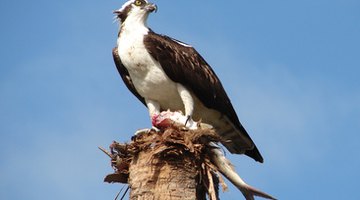DDT, first used for wartime mosquito control, became the world's primary pesticide. Contaminating water supplies and entering food plants, DDT penetrated the entire food web. In 1972 the U.S. banned DDT.
Effects

Sprayed crops are eaten by "primary consumers" -- insects, mice, rabbits -- eaten in turn by carnivores. Washed into water supplies, DDT contaminates plankton eaten by fish. DDT in fish makes the eggs of osprey, eagles and pelicans thin-shelled. They crack, killing embryos. By the 1960s some birds of prey were failing to reproduce. The bald eagle -- America's national symbol -- was declining despite having been protected since 1940.
- Sprayed crops are eaten by "primary consumers" -- insects, mice, rabbits -- eaten in turn by carnivores.
- Washed into water supplies, DDT contaminates plankton eaten by fish.
Time frame
Settling in the fatty tissues, DDT is not excreted. Levels build -- "bioaccumulate" -- as more is consumed. DDT is long-lasting. Persisting in animal tissues and the environment, spreading to other species through consumption, DDT is still entering food webs years after its last use.
- Settling in the fatty tissues, DDT is not excreted.
Biomagnification
DDT concentration increases as it moves up the food chain. Plants and insects contain small amounts of DDT but rabbits eat many plants, and small birds eat thousands of insects, multiplying the effect within their tissues. Consuming numerous rabbits and birds, eagles accumulate greatly magnified DDT levels. 1967 research in Long Island Sound found DDT levels magnified 202,368 times between entry into the water and accumulation in fish-eating gulls.
- DDT concentration increases as it moves up the food chain.
- Plants and insects contain small amounts of DDT but rabbits eat many plants, and small birds eat thousands of insects, multiplying the effect within their tissues.
